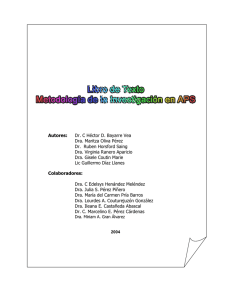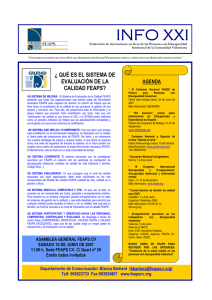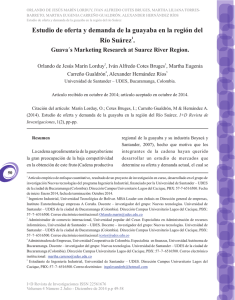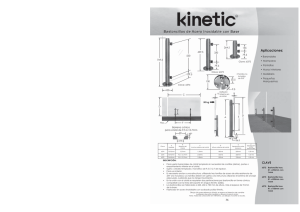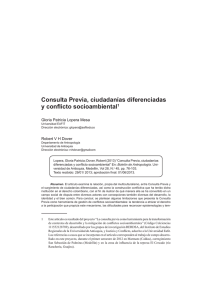Effect of greenhouse heights on the production
Anuncio
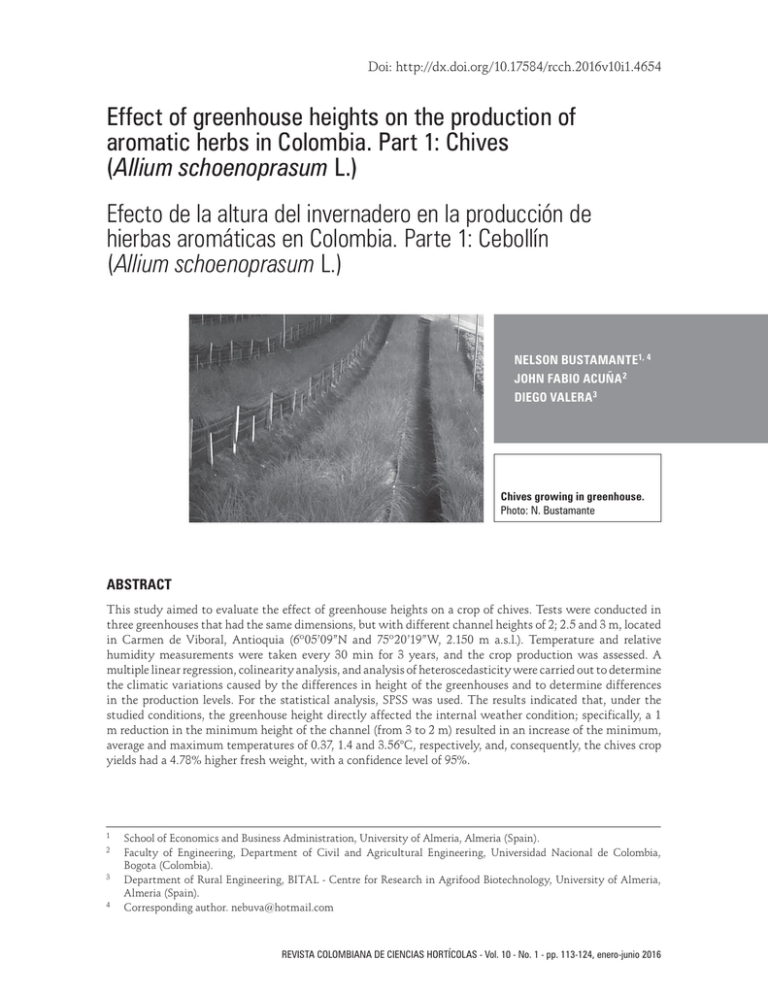
Doi: http://dx.doi.org/10.17584/rcch.2016v10i1.4654
Effect of greenhouse heights on the production of
aromatic herbs in Colombia. Part 1: Chives
(Allium schoenoprasum L.)
Efecto de la altura del invernadero en la producción de
hierbas aromáticas en Colombia. Parte 1: Cebollín
(Allium schoenoprasum L.)
NELSON BUSTAMANTE1, 4
JOHN FABIO ACUÑA 2
DIEGO VALERA3
Chives growing in greenhouse.
Photo: N. Bustamante
ABSTRACT
This study aimed to evaluate the effect of greenhouse heights on a crop of chives. Tests were conducted in
WKUHHJUHHQKRXVHVWKDWKDGWKHVDPHGLPHQVLRQVEXWZLWKGLIIHUHQWFKDQQHOKHLJKWVRIDQGPORFDWHG
LQ &DUPHQ GH 9LERUDO $QWLRTXLD ·µ1 DQG ·µ: P DVO 7HPSHUDWXUH DQG UHODWLYH
KXPLGLW\ PHDVXUHPHQWV ZHUH WDNHQ HYHU\ PLQ IRU \HDUV DQG WKH FURS SURGXFWLRQ ZDV DVVHVVHG $
multiple linear regression, colinearity analysis, and analysis of heteroscedasticity were carried out to determine
the climatic variations caused by the differences in height of the greenhouses and to determine differences
in the production levels. For the statistical analysis, SPSS was used. The results indicated that, under the
VWXGLHGFRQGLWLRQVWKHJUHHQKRXVHKHLJKWGLUHFWO\DIIHFWHGWKHLQWHUQDOZHDWKHUFRQGLWLRQVSHFLILFDOO\D
m reduction in the minimum height of the channel (from 3 to 2 m) resulted in an increase of the minimum,
average and maximum temperatures of 0.37, 1.4 and 3.56°C, respectively, and, consequently, the chives crop
yields had a 4.78% higher fresh weight, with a confidence level of 95%.
1
2
3
4
6FKRRORI(FRQRPLFVDQG%XVLQHVV$GPLQLVWUDWLRQ8QLYHUVLW\RI$OPHULD$OPHULD6SDLQ
)DFXOW\ RI (QJLQHHULQJ 'HSDUWPHQW RI &LYLO DQG $JULFXOWXUDO (QJLQHHULQJ 8QLYHUVLGDG 1DFLRQDO GH &RORPELD
%RJRWD&RORPELD
'HSDUWPHQWRI5XUDO(QJLQHHULQJ%,7$/&HQWUHIRU5HVHDUFKLQ$JULIRRG%LRWHFKQRORJ\8QLYHUVLW\RI$OPHULD
$OPHULD6SDLQ
&RUUHVSRQGLQJDXWKRUQHEXYD#KRWPDLOFRP
REVISTA COLOMBIANA DE CIENCIAS HORTÍCOLAS - Vol. 10 - No. 1 - pp. 113-124, enero-junio 2016
114
BUSTAMANTE/ ACUÑA/ VALERA
Additional keywords: climate control, temperature, relative humidity, yield.
RESUMEN
El objetivo del estudio fue evaluar la incidencia de la altura del invernadero sobre la producción en un cultivo
de cebollín. Los ensayos se realizaron en tres invernaderos de iguales dimensiones, variando solamente su
DOWXUDGHFDQDOGHP\PUHVSHFWLYDPHQWHXELFDGRVHQHO&DUPHQGH9LERUDO$QWLRTXLD·µ1
\·µ:PVQP6HUHDOL]DURQPHGLFLRQHVGHWHPSHUDWXUD\KXPHGDGUHODWLYDFDGDPLQSRU
años, durante los cuales se evaluó la producción del cultivo. Se realizaron análisis de regresión lineal múltiple,
análisis de colinealidad y análisis de heterocedasticidad para determinar las variaciones climáticas causadas
por la diferencia de altura entre los invernaderos y para determinar las diferencias en los niveles de producción.
Se utilizó el software SPSS para el análisis estadístico. Los resultados indican que para las condiciones del estudio, la altura del invernadero afecta directamente las condiciones climáticas internas, donde una reducción
de 1 m de altura de canal (pasando de 3 a 2 m) genera un incremento de las temperaturas mínima, promedio
\Pi[LPDGH\&UHVSHFWLYDPHQWHDVtFRPRXQUHQGLPLHQWRVXSHULRUHQHQSHVRFRQ
niveles de confiabilidad de 95%
Palabras clave adicionales: control climático, temperatura, humedad relativa, rendimiento.
Received for publication: 16-03-2016
Accepted for publication: 14-05-2016
INTRODUCTION
Plants that are from the same genotype, but
planted under different weather conditions may
have different development stages as a result of
the biological life cycle, which changes with the
genotype and climatic factors at the end of the
VDPH FKURQRORJLFDO WLPH %LRORJLFDO HYHQWV DUH
used as indicators for the presence or absence of
certain environmental factors to draw certain
FRQFOXVLRQVRUPDNHSUHGLFWLRQVDERXWSODQWUHVSRQVHV %UXHFNQHU DQG 3HUQHU 'DKOJUHQ
et al., 2007). Changes in the environment exert
different pressures on plants and influence the
development of each species, resulting in various
forms of growth, which could be interpreted as
different paths that plants have followed to adapt
to a particular environment (Sherry et al., 2007).
Rev. Colomb. Cienc. Hortic.
The development rate in crops, defined as a progressive sequence of distinct morphological and
physiological states, is influenced by thermal
energy, the main environmental factor (Sadras
et al /DPEHUV et al., 2008). The growth
evolution, transport of assimilates, evolution of
the fundamental metabolic processes, leaf expansion dynamics and biomass partition factors
can be modified by environmental conditions
(Salisbury and Ross, 2000). The sensitivity of the
plant to ecophysiological factors depends on the
species (genotype) and its developmental stage
(Fischer and Melgarejo, 2014). It is very difficult
to discuss the influence of the climate because
of its combination with many different factors
that are constantly changing during the growth
EFFECT OF GREENHOUSE HEIGHTS ON THE PRODUCTION OF CHIVES
cycle of a crop, not only with each varying factor, but also with the dynamics of all of the factors (Fischer and Orduz-Rodríguez, 2012).
Chives (Allium schoenoprasum L.) is an aromatic
herb with a perennial growth habit and many
self-renewal cycles in the vegetative structures
ZLWKEXOELOV'HODKDXWDQG1HZHQKRXVH
$EHOORet al:KLWWLQJKLOOet al., 2013). The
leaves are longer than 7 cm with a delicate aroma
and are used in fresh consumption, improving
WKHWDVWHRIGLIIHUHQWPHDOV%HUQDOet al
0DURĀNLHQHet al., 2013). Chives is highly adapted
WRWKHFROGFOLPDWHVRIWURSLFDO6RXWK$PHULFDDW
altitudes between 2,000 and 2,800 m, and grows
IDYRUDEO\LQJUHHQKRXVHV&ODYLMR%DUUHxR
2006).
Weather is a determining factor in the growth of
plants and their response to these factors depends
on the variety and physiological state (Quintero
DQG$FXxD*UHHQKRXVHVDUHXVHGWRPRGify weather conditions, protect crops, and inFUHDVHSURGXFWLRQDQGTXDOLW\*RQ]iOH]
through the appropriate selection of a film cover,
changes in geometry, and ventilation area, using
the combined action of wind and buoyancy forces (Roy et al3LQ]yQet al., 2013).
0.5 m
3.0 m
6.8 m
Greenhouse 11
Greenhouse
This paper aims to show that, by changing the
height of a greenhouse, different climatic conditions are generated, providing the most appropriate greenhouse height for growing chives in
tropical mountains.
MATERIALS AND METHODS
Three metal multi-tunnel greenhouses, 1,523
m2 ZHUH SODFHG LQ &DUPHQ GH 9LERUDO $QWLRTXLD ·µ 1 DQG ·µ : P
a.s.l.). Each greenhouse had 33 raised beds, 1 m
wide by 25 m long, with a distribution of 11 beds
for a mint crop, 11 beds for chives and 11 beds
IRUDQRUHJDQRFURS$OORIWKHJUHHQKRXVHVKDG
WKH VDPH GLPHQVLRQV DQG URRI VORSHV RQO\ WKH
channel height at the end of greenhouses was
changed: 2 m, 2.5 m and 3 m (figure 1).
7KHVWUXFWXUHVKDGµJDOYDQL]HGORQJLWXGLQDO
and transverse cables that were anchored to the
ground, creating four 6.8 u 56 m bays with 4 m
columns. Screens are distributed around the perimeter, two side screens (1.2 m u 54 m) and two
front screens (1.2 m u 25.2 m), operated manually, which were opened at 6 a.m. and closed at 4
p.m. (figure 2).
0.5 m
2.5 m
6.8 m
Greenhouse 22
Greenhouse
0.5 m
6.8 m
2.0 m
Greenhouse
Greenhouse33
Figure 1. Dimensions of the gates of the top rear of the three greenhouses.
Vol. 10 - No. 1 - 2016
115
116
BUSTAMANTE/ ACUÑA/ VALERA
u
pli
3.0 m
1.2 m
upper wall
plinth
6.8 m
1.0 m
1.2 m
nt
e
pp
rw
all
h
4m
27.2 m
Figure 2. Section of the isometric drawing of greenhouse 3 and dimensions of the front and lateral ventilation
areas.
The production was monitored in the three
greenhouses and measurements of the weather
FRQGLWLRQV RXWVLGH WKH JUHHQKRXVHV ZHUH WDNHQ
RYHU D SHULRG RI \HDUV VWDUWLQJ RQ -DQXDU\ 2012.
two studied variables (temperature and humidLW\ ZLWK WKH UHVSRQVH YDULDEOH SURGXFWLRQ $
colinearity analysis was used to study the relationship between the two independent variables (temperature and relative humidity), which
helped interpret the data obtained from the linear regression and analysis of heteroscedasticity,
verifying that the variance of the input disturbance variables was not constant. For the statistical analysis, SPSS was used.
$EDVHOLQHLUULJDWLRQIHUWLOL]DWLRQDQGVSUD\ing program was implemented, so that the
overall handling of the three crops in these
areas was a constant factor in this study. The
spraying was carried out based on the moniWRULQJWDNHQLQWKHILHOGZLWKLQGLFDWLRQVDQG
SUHYHQWLYHQRWVKRFNGRVDJHVLQRUGHUWRQRW ANALYSIS AND DISCUSSION
DOWHUWKHSURGXFW7KHFURSZRUNDQGZHHGLQJ OF RESULTS
ZHUHGRQHHYHU\ZHHNVKRHLQJZDVGRQHHYChives production data
ery 3 months.
The temperature and relative humidity were analyzed in the greenhouses throughout the study,
IURP-DQXDU\WR-DQXDU\'XUing this period, two full cycles of chives (12 cuts
per cycle) and the first four cuts of the third cycle
were measured, for a total of 308 pieces of data
for the greenhouse production.
The data were subjected to a multiple linear regression to study the relationship between the
Rev. Colomb. Cienc. Hortic.
Table 1 shows the summarized total production
of cut leaves, obtained per cycle and per greenhouse. It indicates that the highest production
WRRN SODFH LQ WKH PKLJKJUHHQKRXVH ZLWK
NJRIFKLYHVSURGXFHGWKLVJUHHQKRXVH
had a minimum channel height of 2 m. While for
greenhouse 1 and greenhouse 2, the production
did not differ by more than 1.15%, but comparing greenhouse 1 with greenhouse 3 showed a
difference in production of 5.01%.
EFFECT OF GREENHOUSE HEIGHTS ON THE PRODUCTION OF CHIVES
Table 1.
Total chives production per cycle and per greenhouse.
Chives production (kg)
Greenhouse 1
(3.0 m height)
Greenhouse 2
(2.5 m height)
Greenhouse 3
(2.0 m height)
Cycle 1
4,764.55
4,97.13
5,036.62
Cycle 2
4,840.47
4,809.89
5,027.74
Total (kg)
9,605.02
9,707.02
10,064.36
The results clearly state that the best chives proGXFWLRQWRRNSODFHLQWKHORZKLJKJUHHQKRXVH
Similar results were found by Roy et al. (2002),
who observed that differences between greenhouses resulted from heat lost in ventilation, providing different climate conditions for the crops.
The cultivation of chives has a production cycle
RI PRQWKV WKLV VWXG\ ODVWHG \HDUV VR WKH
production data came from a total of 28 cuts for
the cycles mentioned above.
For instance, in the case of the 2nd greenhouse,
the model says that the joint variation of the
Tmean and HRmean was explained by 10.2%
the variations in the obtained fresh weight. The
statistical DW for the 3 cases was lower than 2,
indicating that there was a negative autocorrelation between the predicting variables. This coincides with the normal behavior of these two
variables, where one has higher temperature and
lower relative humidity and vice versa.
Statistical analysis
In order to determine if the regression model
ZDV YDOLG JOREDOO\ DQ $QRYD YDULDQFH DQDO\sis (table 3) was performed to jointly verify the
explanatory variables or predictors (RH and T),
which provide information explaining the reVSRQVH RU GHSHQGHQW YDULDEOH IUHVK ZHLJKW $
similar answer was obtained in lettuce (Lactuca
sativa) under two different greenhouse films by
%DXWLVWD7RUUHVet al. (2014).
Linear regression of the chives crop data
The regression analysis of the chives was done
depending on the temperature and relative humidity as a first step for statistically evaluating
the influence of these variables on the response
YDULDEOHZKLFKZDVWKHSURGXFWLRQZHLJKWNJ
The input variables included temperature and
relative humidity in the regression model, and
WKHGHSHQGHQWYDULDEOHZDVIUHVKZHLJKWNJ
Once the variables were introduced into the regression process with SPSS (Pardo and Ruiz. 2005), the
results shown in table 2 were obtained (table 2).
The data showed the existence of a global linear
association between the independent variables
and the response variable because R2 was different from 0 in the three greenhouses. Its magnitude suggests that the percentage explained of
the variations in the response variable was given
by the variations of the independent variables
(Kleinbaum et al., 1988).
The null hypothesis in this case was that the
predictor variables were not linearly related to
the dependent variable. For this, the value of
the F statistic was compared with the critical
value given by the degrees of freedom of the
table and a significance level by 5%. The critical value and the comparison were calculated
internally with the software, expressing the Sig
value with a value equal to 0.000. This value
indicates that, with a significance level by 5%,
there was certainly a significant linear relationship between the crop production (measured in
NLORJUDP RI IUHVK ZHLJKW DQG WKH UHODWLYH KXmidity and temperature variables of each of the
JUHHQKRXVHV$IWHUYHULI\LQJWKHYDOLGLW\RIWKH
model, we proceeded to calculate the regression
Vol. 10 - No. 1 - 2016
117
BUSTAMANTE/ ACUÑA/ VALERA
118
Table 2. Linear regression model summaryb.
R
R square
Adjusted R
square
1 (3 m height)
.306a
0.094
0.088
15.548
0.051
2 (2.5 m height)
.320a
0.102
0.096
15.632
0.068
3 (2 m height)
.311a
0.096
0.091
15.999
0.076
Greenhouse
Std. error of the
estimate
Durbin-Watson
a Variables
b
predictors: (constant), Tmean_L1, HRmean_L1.
Dependent variable: fresh weight (kg).
Table 3. Analysis of variance1 (Anova).
Sum of
squares
Greenhouse
Regression
1
F
Sig.
15.79
.000 2
17.35
.000 2
16.29
.000 2
2
3816.04
Residual
73729.94
305
241.74
Total
81362.02
307
8480.34
2
4240.17
Residual
74528.09
305
244.35
Total
83008.44
307
Regression
3
Mean square
7632.08
Regression
2
df
8337.51
2
4168.75
Residual
78070.61
305
255.97
Total
86408.11
307
1 Dependent
2 Variables
variable: fresh weight (kg).
predictors: (constant), Tmean_L1, HRmean_L1.
coefficients, as shown in table 4.
The t test values and their level of significance
(Sig.) are used to compare the null hypothesis
ZLWK WKH UHVSHFWLYH UHJUHVVLRQ FRHIILFLHQWV WDNH
D ]HUR YDOXH $FFRUGLQJ WR WKH UHVXOWV WKH QXOO
hypothesis is rejected in all cases, that is, all of
the obtained coefficients were relevant to the
regression equation. Meanwhile, the values of
statistical collinearity showed that this charac-
teristic did not affect the validity of the model
since any values higher than 10 are obtained in
the variance inflation factor-VIF (Kleinbaum et
al., 1988).
The following chives crop regression equations
were used to forecast the production value according to variations in the temperature and relative humidity for each greenhouse:
The linear regression procedure comes from the
Greenhouse 1 equation:
Fresh weight (kg) = -472.36 + HRmean 7,889 * - 9,928 * Tmean
(1)
Greenhouse 2 equation:
Fresh weight (kg) = -615.77 + 9.49 * HRmean - 9.43 * Tmean
Rev. Colomb. Cienc. Hortic.
(2)
EFFECT OF GREENHOUSE HEIGHTS ON THE PRODUCTION OF CHIVES
119
Greenhouse 3 equation:
Fresh weight (kg) = -441.32 + 7.72 * HRmean - 10.84 * Tmean
assumptions of normality and homoscedasticity of residue, i.e. the behavior of the differences
between the equation predicted values and the
actual value follows the normal distribution. In
order to evaluate this, the normal probability
of curves is devised:
(3)
The three methods of Pardo and Ruiz (2005) to
interpret the above table to determine the presence of collinearity are as follows:
• When most of the eigenvalues are close to zero.
• When the condition indexes are greater than 30.
$VVKRZQLQWKHFKDUWVLQDOOWKUHHFDVHVWKHUH
was a tendency of the point cloud to align to • For higher indexes, when two or more factors
have a larger proportion to the variance.
the diagonal line on the graph, which indicates
that the normality assumption in the data is
true.
These three conditions are met for all greenhouses, meaning that it is confirmed that the data obtained from measurements stored are consistent
Regression collinearity analysis
with the normal behavior of these two variables.
of the chives crop data
The collinearity analysis helped to confirm if
there was high ratio of dependent or predictor
variables. This happened because of the inverse
relationship between temperature and relative
humidity under normal conditions. In order to
verify statistically, a collinearity test is done,
which results are shown in table 5.
Correlations of the chives crop data
For the assumption of normality in the data
(n=308), at the beginning, a Pearson correlation
(table 6) was done, which was performed when
WKH GDWD IROORZHG D QRUPDO GLVWULEXWLRQ $GGLtionally, two additional correlations were used,
Table 4. Linear regression model-coefficients 1.
Greenhouse
Variables
(constant)
1
-472.36
677.487
Sig.
Beta
Collinearity statistics
Tolerance
-0.69
0.486
VIF
7.889
6.915
0.131
1.141
0.255
0.224
4.455
-9.928
6.196
-0.184
-1.60
0.11
0.224
4.455
-615.77
681.14
-0.90
0.37
9.49
6.95
0.16
1.37
0.17
0.22
4.46
-0.17
-1.51
0.13
0.22
4.46
-0.63
0.53
HRmean
(constant)
HRmean
Tmean
1 Dependent
Std. error
t
Tmean
Tmean
3
B
Standardized
coefficients
HRmean
(constant)
2
Unstandardized
coefficients
-9.43
6.23
-441.32
697.14
7.72
7.12
0.13
1.09
0.28
0.22
4.46
-10.84
6.38
-0.20
-1.70
0.09
0.22
4.46
variable: fresh weight (kg).
Vol. 10 - No. 1 - 2016
120
BUSTAMANTE/ ACUÑA/ VALERA
Table 5. Collinearity diagnostics 1.
Greenhouse
Dimension
1
2
3
1 Dependent
Eigenvalue
Condition
index
Variance proportion
(constant)
HRmean_L1
Tmean_L1
1
3
1
0
0
0
2
0
106.068
0
0
0.19
3
9.69E-07
1759.752
1
1
0.81
1
3
1
0
0
0
2
0
106.068
0
0
0.19
3
9.69E-07
1759.752
1
1
0.81
1
3
1
0
0
0
2
0
106.068
0
0
0.19
3
9.687E-07
1759.752
1
1
0.81
variable: fresh weight (kg).
WKH .HQGDOO 7DXBE WDEOH DQG WKH 6SHDUPDQ
7DXBEWDEOHZKLFKDUHXVHGDVDOWHUQDWLYHVWR
Pearson, when the studied variables violate the
assumption of normality.
%\DQDO\]LQJWKHVLJQVRIWKHWKUHHFRUUHODWLRQFRHIficients, it was shown that in all cases a significant
negative correlation between the relative humidity
and the fresh weight of the crop occurred. Similarly, regarding the temperature, there was a significant negative correlation between the relative
humidity and the fresh weight. This is consistent
with the production results obtained in the three
greenhouses, where greenhouse 3, which was the
warmest, had the highest production levels, and in
turn, greenhouse 1, which was the coldest, had the
lowest yields. It is worth noting that the strongest
coefficient was the one from the reverse correlation
between temperature and relative humidity, which
is explained by the strong inverse relationship of
these variables.
Since temperature influences more than the tissue growth of plants, it is possible that this combination of a higher temperature and a lower relative humidity in the 2 m-high-greenhouse had
the most favorable influence on the production
cycle of the chives leaves (Salisbury and Ross,
2000). Chives production has a range between
Rev. Colomb. Cienc. Hortic.
15 to 25o&9LOODPL]DU$QLQFUHDVHLQWKH
RSWLPXPFURSWHPSHUDWXUHUDQJHIDYRUVTXLFNHU
physiological processes because of an increase
LQWKHNLQHWLFHQHUJ\RIWKHHQ]\PDWLFV\VWHPV
(Fischer and Orduz-Rodríguez, 2012).
Heteroscedasticity analysis
$IWHUVWDWLVWLFDOO\FKHFNLQJWKHLQIOXHQFHRIWKH
relative humidity and temperature in the production of each culture for each greenhouse, an
analysis of the behavior of the variation in both
climate variables between the three greenhouses was done regardless of the response variable.
This led to the conclusion of a statistical presence of different microclimates among the three
evaluated greenhouses.
In order to do that, an analysis of variance
(n=113) of two variables evaluating the behavior of their minimum, maximum and average in
both cases was made, so that the analysis
goes from two to six variables.
In all cases, the standard deviation was similar
among the analyzed variables, so this implies
that the data have a similar variation with respect to its mean value. In the three greenhouses,
the temperature had a similar behavior in the
EFFECT OF GREENHOUSE HEIGHTS ON THE PRODUCTION OF CHIVES
121
Table 6. Pearson´s correlation results 1.
Greenhouse
Greenhouse 1
Greenhouse 2
Greenhouse 3
Variable
Parameter
Fresh weight
(kg)
HRmean
(%)
Tmean
(°C)
Fresh weight
(kg)
HRmean
(%)
Tmean
(°C)
Fresh weight
(kg)
HRmean
(%)
Tmean
(°C)
Pearson correlation
Sig. (2-tailed)
Pearson correlation
Sig. (2-tailed)
Pearson correlation
Sig. (2-tailed)
Pearson correlation
Sig. (2-tailed)
Pearson correlation
Sig. (2-tailed)
Pearson correlation
Sig. (2-tailed)
Pearson correlation
Sig. (2-tailed)
Pearson correlation
Sig. (2-tailed)
Pearson correlation
Sig. (2-tailed)
Fresh weight (kg)
HRmean (%)
.294**
0.000
1
.294**
0.000
-.300**
0.000
1
-.881**
0.000
.309**
0.000
1
.309**
0.000
-.311**
0.000
1
-.881**
0.000
.297**
0.000
1
.297**
0.000
-.305**
0.000
-.881**
0.000
Fresh weight (kg)
HRmean (%)
1
Tmean (°C)
-.300**
0.000
-.881**
0
1
-.311**
0.000
-.881**
0.000
1
-.305**
0.000
-.881**
0.000
1
1 n=308.
** Correlation is significant at the 0.01 level (2-tailed).
Table 7.
Kendall’s tau-b correlation results 1.
Greenhouse
1
2
3
Variable
Parameter
Tmean (°C)
Fresh weight
(kg)
HRmean
(%)
Tmean
(°C)
Fresh weight
(kg)
HRmean
(%)
Tmean
(°C)
Correlation coefficient
Sig. (2-tailed)
Correlation coefficient
Sig. (2-tailed)
Correlation coefficient
Sig. (2-tailed)
Correlation coefficient
Sig. (2-tailed)
Correlation coefficient
Sig. (2-tailed)
Correlation coefficient
Sig. (2-tailed)
1
.
-.218**
0.000
+.221**
0.000
1
.
-.234**
0.000
+.238**
0.000
.218**
0.000
1
.
-.680**
0.000
.234**
0.000
1
.
-.680**
0.000
-.221**
0.000
-.680**
0
1
.
-.238**
0.000
-.680**
0.000
1
.
Fresh weight
(kg)
Correlation coefficient
Sig. (2-tailed)
1
.
.217**
-.219**
HRmean
(%)
Tmean
(°C)
Correlation coefficient
Sig. (2-tailed)
Correlation coefficient
Sig. (2-tailed)
-.217**
0.000
+.219**
0.000
0.000
1
.
-.680**
0.000
0.000
-.680**
0.000
1
.
1
n=308.
** Correlation is significant at the 0.01 level (2-tailed).
Vol. 10 - No. 1 - 2016
BUSTAMANTE/ ACUÑA/ VALERA
122
Table 8. Spearman´s correlation results 1.
Greenhouse
Variable
Parameter
Fresh weight
(kg)
Correlation coefficient
Sig. (2-tailed)
1
.
.338**
0.000
0.000
HRmean
(%)
Correlation coefficient
Sig. (2-tailed)
-.338**
-.861**
0.000
1
.
Tmean
(°C)
Correlation coefficient
Sig. (2-tailed)
+.308**
-.861**
0.000
0.000
1
.
Fresh weight
(kg)
Correlation coefficient
Sig. (2-tailed)
1
.
.367**
-.327**
0.000
0.000
HRmean
(%)
Correlation coefficient
Sig. (2-tailed)
-.367**
1
.
-.861**
0.000
Tmean
(°C)
Correlation coefficient
Sig. (2-tailed)
+.327**
-.861**
0.000
0.000
1
.
Fresh weight
(kg)
Correlation coefficient
Sig. (2-tailed)
1
.
.323**
-.306**
0.000
0.000
HRmean
(%)
Correlation coefficient
Sig. (2-tailed)
-.323**
-.861**
0.000
1
.
Tmean
(°C)
Correlation coefficient
Sig. (2-tailed)
+.306**
-.861**
0.000
0.000
1
.
1
2
3
Fresh weight (kg)
HRmean (%)
Tmean (°C)
-.308**
0
0.000
0.000
1
n=308.
** Correlation is significant at the 0.01 level (2-tailed).
order of values. In all three cases, the coldest
greenhouse was greenhouse 1 and the warmest
was greenhouse 3. Comparing the mean of the
minimum temperatures, the difference between
WKHVH WZR JUHHQKRXVHV ZDV & ZKLOH WKH
difference between greenhouse 2 was 0.29°C.
For the mean of the average temperatures, the
difference between greenhouse 1 and greenhouse
3 was 1.42 and 1.13°C between greenhouse 2 and
greenhouse 3. Finally, the difference between the
mean maximum temperatures was 3.56°C for
greenhouse 1 DQG JUHHQKRXVH DQG & EHtween greenhouse 2 and greenhouse 3.
lowest average and minimum relative humidity
was greenhouse 3, and the one with the highest values was greenhouse 1, with differences
of 6.9% in the mean of the minimum variable
and 2.96% in the mean of the averages. The differences between greenhouse 3 and greenhouse
2 were 5.23% and 2.10%, respectively. With respect to the maximum variables, no significant
differences were found because there is a clear
tendency for values very close to 100% almost
every day in the morning, both outside and inside the greenhouses.
To confirm that the differences between the
$V IRU WKH UHODWLYH KXPLGLW\ YDULDEOHV LQ WKH GHVFULSWLRQVZHUHPHDQLQJIXODQ$129$YDU
minimum and average variables, there was an L-ance analysis was done, starting from the
opposite behavior, which was expected because null hypothesis that the mean of each of the
of the negative correlation that occurred between variables was the same for the three greenthese two variables. The greenhouse with the houses.
Rev. Colomb. Cienc. Hortic.
EFFECT OF GREENHOUSE HEIGHTS ON THE PRODUCTION OF CHIVES
The comparison of statistic F resulted in the
null hypothesis being rejected in all cases (Sig.
H[FHSWIRUWKH+5BPHDQ7KLVPHDQV
that, for a confidence level of 95%, it can be said
that there were significant differences in the
RWKHU ILYH YDULDEOHV 7B0,1 7BPHG WBPD[
+UBPLQDQG+5BPD[
ded that, for a confidence level of 95%, the reduction of 1 m in the minimum height of the
channel resulted in an increase of: of 0.37°C in
the minimum temperature, 1.42°C in the average temperature and 3.56°C in the maximum
temperature.
• For a confidence level of 95%, it was concluded
that, by reducing the minimum height channel
from 3 m to 2 m, there is a difference in the microclimate of the greenhouse in the study, which
produced an increase of 4.78% in the production
of the chives, which resulted in a rise of income.
• In the case of relative humidity, the 1 m reduction of the minimum height resulted in a
decrease in the minimum relative humidity
of 6.9% and 2.96% in the average relative humidity. The inverse relationship between the
relative humidity and temperature was due to
the high negative statistical correlation seen
between these two variables according to the
three statistical correlation methods and the
Durbin Watson statistic.
• The microclimate generated in each greenhouse was described by the differences in the
five variables with which the heteroscedasticity analysis (Tmean, Tmin, Tmax, minimum
HR and HR mean) was done. It was conclu-
• With a confidence level of 95%, it was shown
that there was a significant linear relationship
between the joint interaction of relative humidity and temperature and the production of
chives crops in each of the greenhouses.
CONCLUSIONS
BIBLIOGRAPHIC REFERENCES
$EHOOR--&ODYLMRDQG3%DUUHQR(VWXGLRSUHliminar de algunos descriptores fisiológicos en
cinco hierbas aromáticas. pp. 13-15. In: Memorias
Curso de Extensión: Últimas tendencias en hierbas
aromáticas culinarias para exportación en fresco.
)DFXOWDG GH $JURQRPtD 8QLYHUVLGDG 1DFLRQDO GH
&RORPELD%RJRWi
%DUUHxR3+LHUEDVDURPiWLFDVFXOLQDULDVSDUDH[portacion en fresco. Manejo agronómico, producFLyQ\FRVWRV)DFXOWDGGH$JURQRPtD8QLYHUVLGDG
1DFLRQDOGH&RORPELD%RJRWi
%DXWLVWD7RUUHV$0-)$FXxDDQG-/0DUWLQ
Comportamiento de la humedad relativa en un cultivo de lechuga (Lactuca sativa) variedad Vera, bajo
dos condiciones de ambiente controlado. In: MePRULDV;,&RQJUHVR/DWLQRDPHULFDQR\GHO&DULEH
GH,QJHQLHUtD$JUtFROD&DQF~Q0p[LFR
%HUQDO'$/&0RUDOHV*)LVFKHU-&XHUYRDQG
6 0DJQLWVNL\ &DUDFWHUL]DFLyQ GH ODV GH-
ficiencias de macronutrientes en plantas de cebollín (Allium schoenoprasum L.). Rev. Colomb.
Cienc. Hortic. 2(2), 192-204. Doi: 10.17584/
rcch.2008v2i2.1187
%UXHFNQHU%DQG+3HUQHU'LVWULEXWLRQRIQXWULtive compounds and sensory quality in the leafs of
chives (Allium schoenoprasum/-$SSO%RW)RRG
Qual. 80(2), 155-159..
&ODYLMR -3 ÔOWLPDV WHQGHQFLDV HQ KLHUEDV
aromáticas culinarias para exportacion en fresco.
3URGXPHGLRV%RJRWi
'DKOJUHQ-3+YRQ=HLSHODQG-(KUOHQ2007. Variation in vegetative and flowering phenology in a
forest herb caused by environmental heterogeneLW\ $PHU - %RW 'RL ajb.94.9.1570
'HODKDXW.$DQG$&1HZHQKRXVH*URZLQJ
RQLRQVJDUOLFOHHNVDQGRWKHU$OOLXPLQ:LVFRQ-
Vol. 10 - No. 1 - 2016
123
124
BUSTAMANTE/ ACUÑA/ VALERA
VLQ$JXLGHIRUIUHVKPDUNHWJURZHUV&RRSHUDWLYH
H[WHQVLRQ8QLYHUVLW\RI:LVFRQVLQ0DGLVRQ:,
)LVFKHU*DQG/00HOJDUHMR(FRILVLRORJtDGHOD
uchuva (Physalis peruviana L.). pp. 31-47. In: CarvalKR&3DQG'$0RUHQRHGVPhysalis peruviana:
fruta andina para el mundo. Programa IberoameriFDQRGH&LHQFLD\7HFQRORJtDSDUDHO'HVDUUROOR²
&<7('/LPHQFRS6/$OLFDQWH6SDLQ
)LVFKHU * DQG -2 2UGX]5RGUtJXH] (FRILVLRORJtD HQ IUXWDOHV SS ,Q )LVFKHU * HG
Manual para el cultivo de frutales en el trópico.
3URGXPHGLRV%RJRWi
*RQ]iOH]00/DJHVWLyQGHOFOLPDEDMRLQYHUnadero y modelos de simulación para su manejo.
Memorias Curso Control climático en invernadeURV8QLYHUVLGDGGH$OPHUtD$OPHUtD(VSDxD
.OHLQEDXP'*/ /.XSSHUDQG.0XOOHU$SSOLHG
regression analysis and other multivariate methods.
3:6.(17 3XEOLVKLQJ &RPSDQ\ .HQW 8.
Lambers, H., T.L. Pons, and S. Chapin. 2008. Plant phyVLRORJLFDO HFRORJ\ QG HG 6SULQJHU 9HUODJ 1HZ
<RUN1<
0DURĀNLHQH15.DUNOHOLHQH'-XåNHYLĀLHQHDQG$
5DG]HYLĀLXV,QYHVWLJDWLRQRIPRUSKRELRORJical parameters of local and introduced cultivars
of chives (Allium schoenoprasum/-6RGLQLQN\VWH
'DUçLQLQN\VWH
3DUGR0DQG'5XL]$QiOLVLVGHGDWRVFRQ6366
%DVH0F*UDZ+LOO0DGULG
3LQ]yQ $0 % &DVWLOOR DQG 07 /RQGRxR Characterization of the mechanical properties of
chives (Allium schoenoprasum / $JURQ &RORPE
31(1), 83-88.
4XLQWHUR * DQG -) $FXxD ,QFLGHQFLD GH ODV
películas plásticas en la variación de factores
Rev. Colomb. Cienc. Hortic.
abióticos para producción de lechuga en ambientes protegidos. In: Memorias VI Edición de la
conferencia científica internacional sobre desarUROOR DJURSHFXDULR \ VRVWHQLELOLGDG $JURFHQWUR
8QLYHUVLGDG&HQWUDO´0DUWKD$EUHXµGH/DV9LOlas, Cuba.
5R\-&7%RXODUG&.LWWDVDQG6:DQJConvective and ventilation transfers in greenhouses,
Part 1: the greenhouse considered as a perfectly
VWLUUHGWDQN%LRV\VW(QJ'RL
bioe.2002.0107
6DGUDV92/(FKDUWHDQG)+$QGUDGHProfiles of leaf senescence during reproductive growth
RI VXQIORZHU DQG PDL]H $QQ %RW Doi: 10.1006/anbo.1999.101.
6DOLVEXU\ )% DQG &: 5RVV )LVLRORJtD GH ODV
plantas. Vol. 3. Desarrollo de las plantas y fisiología ambiental. Paraninfo and Thomson Learning, Madrid.
6KHUU\5$;+=KRXDQG6/*X'LYHUJHQFH
of reproductive phenology under climate warmLQJ3URF1DW$FDG6FL86$'RL
10.1073/pnas.0605642104.
Villamizar, F. 2003. Calidad poscosecha y uso del frío
en la conservación de hierbas frescas para la exportación. pp. 51-55. In: Memorias curso de extensión
WHyULFR SUiFWLFR µÔOWLPDV WHQGHQFLDV HQ KLHUEDV
DURPiWLFDVFXOLQDULDVSDUDH[SRUWDFLyQHQIUHVFRµ
)DFXOWDG GH $JURQRPtD 8QLYHUVLGDG 1DFLRQDO GH
&RORPELD%RJRWi
:KLWWLQJKLOO /- '% 5RZH 0 1JRXDMLR DQG
%0 &UHJJ (YDOXDWLRQ RI QXWULHQW PDnagement and mulching strategies for vegetable
SURGXFWLRQ RQ DQ H[WHQVLYH JUHHQ URRI $JURecol. Sustainable Food Syst. 40(4), 297-318. Doi:
10.1080/21683565.2015.1129011
